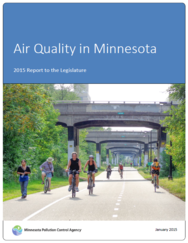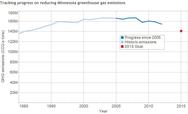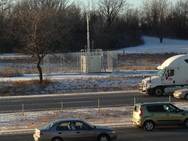Air Mail Newsletter for February 2015
Minnesota Pollution Control Agency sent this bulletin at 02/04/2015 06:57 AM CST
Progress report on reducing Minnesota’s greenhouse gas emissions
New near-road monitoring site
Community Air Monitoring Project
The Community Air Monitoring Project (CAMP) uses funding from the 2013 Minnesota Legislature to do short-term air quality monitoring in selected Minnesota neighborhoods. The objective is to monitor and assess air quality in low-income neighborhoods or communities of color that are disproportionately impacted by air pollution emissions from highways, air traffic, or industrial sources. The monitor is moved every three months, with monitoring results posted to the CAMP website after the data has been quality assured and analyzed.
Since starting the project in October 2013, the Minnesota Pollution Control Agency has completed monitoring at five neighborhood sites. The CAMP monitor is now located in its sixth community, the Lyndale neighborhood in Minneapolis. The MPCA will be monitoring in this community from January 1 to March 31, 2015.
For more information on the Community Air Monitoring Project, please visit the CAMP website or call either 651-296-6300 or 1-800-657-3864 and ask for air data analysis staff. More information about the MPCA’s air monitoring program is available on the MPCA website. Trainings available through the Minnesota Technical Assistance Program
In the news
EPA Agreement with Taconite Plants on Haze Limits Open for Comment
On Friday, January 30, 2015, the U.S. Environmental Protection Agency (EPA) published notice of a proposed settlement agreement to resolve lawsuits by Cliffs Natural Resources and Arcelor Mittal seeking review of its Regional Haze Federal Implementation Plan (FIP), which addressed taconite emissions in Minnesota and Michigan. EPA’s FIP, originally finalized February 6, 2013, required limits on emissions of nitrogen oxides (NOX) and sulfur dioxide (SO2) representing Best Available Retrofit Technology, but it has been stayed, pending the resolution of litigation. The proposed settlement agreement includes new NOX and SO2 limits for the facilities, as well as a schedule for EPA to promulgate revised FIPs incorporating the new limits. Please see the EPA’s website for more information on the taconite FIP.
The comment period for the proposed settlement closes on March 2, 2015. For more information, and to submit comments, please visit the EPA’s regulations.gov page.
Pollution prevention in Minnesota
Minnesota businesses are the best in the United States at reducing or eliminating some dangerous pollutants, according to a recent EPA report. To find out more, visit the MPCA website.
New ozone standard
On November 26, 2014, the EPA proposed revised National Ambient Air Quality Standards for ground-level ozone. The level of the standard would be made more stringent to protect human health and the environment based on current scientific understanding of ozone’s impacts. Local news outlets have been reporting on what the new standards might mean for Minnesota.
Lead standard review
The EPA announced in December that it proposed to retain the current National Ambient Air Quality Standard for lead. The Clean Air Act requires that EPA review its air quality standards every five years to ensure that they are in line with current scientific understanding of the health and environmental impacts of air pollution. EPA’s decision to retain the lead standard comes after review of the current scientific literature on the health impacts of lead. For more information, visit the EPA’s website.
Air quality alert days
In December, the MPCA issued an air quality advisory for southern Minnesota. Stagnant weather patterns trapped fine particles close to the ground. The MPCA partnered with the Minnesota Department of Transportation to get the word out to Minnesotans on traffic signs. Local news outlets reported on the advisory.
Air quality and highways
In a recent report, a local news outlet explored the impacts of traffic on concentrations of particle pollution inside vehicles.
Climate change in Minnesota
This week, Minnesota Public Radio has been conducting an in-depth report on climate change in Minnesota. Subscribe to Air Mail
Air Mail is a quarterly, email-based newsletter featuring updates on air quality issues and the work of the MPCA and our partners. Subscribers to this list also receive Air Mail Bulletins, which provide time-sensitive regulatory and technical updates. To see past issues, Air Mail Bulletins, or to subscribe, visit the MPCA's website. |





